A number of different debridement techniques are available for the management of acute and chronic wounds; as a result the debridement method applied with vary. Methods can be selective or non-selective and this can impact on the surrounding tissue of a wound. This article will look at the various methods of debridement and mechanisms of action which impact on the healing wound and the healthy tissue surrounding it. Debridement is a key aspect of wound management, and decisions on the ideal technique, and the most appropriate method, should be made for optimum healing.
Why do we need to debride?
Debridement is defined as removal of a bioburden and foreign material from a wound (Welsh and Sumpling, 2015). Such material may be necrotic tissue, purulent material, haematomas, foreign bodies, debris, and bone fragments (Strohal et al, 2013). The objective of wound debridement is to promote wound healing (Hamilton and Kožár, 2017). Debridement occurs naturally in all wounds and is part of the inflammatory phase of wound healing. It is driven initially by neutrophils and then by macrophages (Davidson, 2015). Veterinary intervention is valuable because failure to debride a wound is likely to delay wound healing as the inflammatory phase is prolonged, and this may predispose the wound to infection (Welsh and Sumpling, 2015). If all wounds are to heal successfully they are required to pass through the three phases of wound healing — inflammation, proliferation and maturation — and if this process is interrupted the wound will become chronic (Woodlands, 2014). Chronic wounds often require intervention to remove necrotic tissue, a blood supply needs to be re-established and exudate removed (Hamilton and Kožár, 2017). Any devitalised tissue can act as a barrier to impede the healing processes (Wiegand et al, 2016). Factors that affect the choice of method of debridement include wound size, location, aetiology, age of the wound, the systemic condition of the patient, and the presence of infection or exudate (Hamilton and Kožár, 2017).
There are various techniques to conduct debridement which can be divided into two categories: non-selective and selective. Non-selective debridement involves physical removal of necrotic tissue, but may subsequently cause trauma to healthy tissue (Davidson, 2015). Selective debridement will only target necrotic tissue (Welsh and Sumpling, 2015).
The most common non-selective debridement techniques are sharp, surgical and mechanical, but there are various other non-selective techniques that are used including hydro-surgical and ultrasonic debridement. Autolytic is the most common selective debridement technique used, other selective methods include larval therapy and enzymatic debridement (Welsh and Sumpling, 2015). The choice of technique used depends on the individual wound; variations in the nature of the injury, such as whether the wound is an incision, laceration, or a degloving injury, play an important part in decision making for debridement techniques. The level of contamination of a wound, the systemic health of the patient, location of the wound and the financial commitments of the clients should also be considered when a decision on methods of debridement are deliberated. It is common for multiple methods to be used in conjunction for debridement and management of a wound (Welsh and Sumpling, 2015).
Non-selective debridement
Wound irrigation
Wound irrigation is a mechanical debridement technique that is used to clean the wound bed. Irrigation will flush away surface bacteria, any foreign material present, and will even remove necrotic debris (Bowlt and Friend, 2011). This is a non-selective type of debridement, but should not cause any damage to healthy tissues if the correct irrigation solutions are used and the correct pressures (Davidson, 2015). Despite the lack of evidence supporting that wound irrigation will increase healing of the wound or reduce infection, it is recommended in order to reduce bacterial load and help to break down bacterial bioburdens. Solutions should be balanced with electrolytes, however tap water can be used in initial wound irrigation, but care is required as it is hypotonic and can therefore cause cell destruction (Hollis, 2012). Chlorhexidine gluconate 0.05% is documented in varying dilutions for lavage, however care must be taken as it can be cytotoxic to new epithelial cells and therefore can delay granulation tissue formation (Davidson, 2015). Povidone-iodine is documented for use for wound lavage, but is inactivated by organic matter such as blood and exudate. Its residual action is also poor, making it of limited use (Bowlt and Friend, 2011). Pressure to flush wounds has varied through the literature, and the ideal pressure has not been established. However, high pressures may drive bacteria and debris into the tissue planes and damage the tissue. Commonly a 20 ml syringe with an 18 gauge needle is used to generate 7–8 psi (Davidson, 2015) (Figure 1).
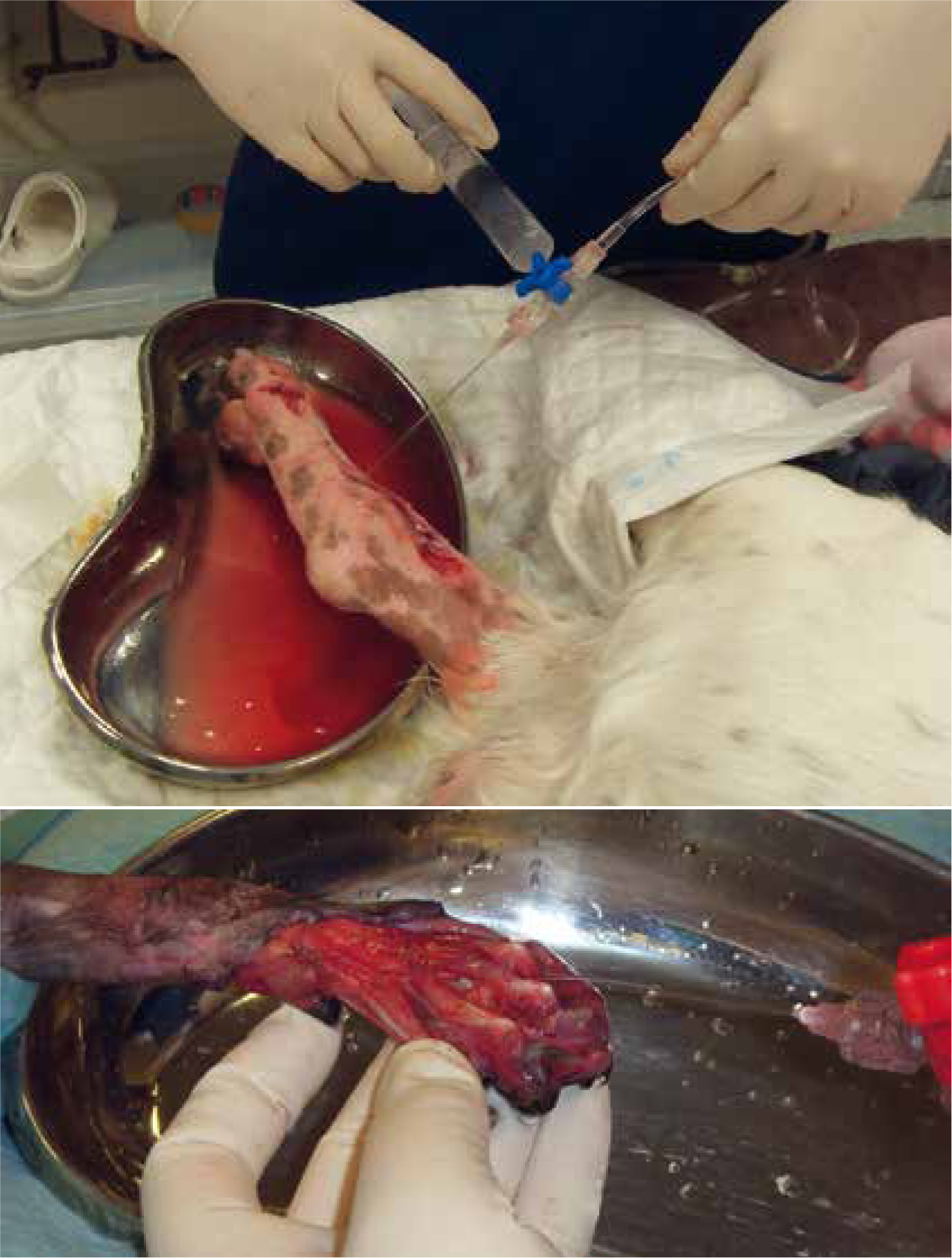
Surgical and sharp
Surgical and sharp debridement is often used in chronic wound healing or if wounds are large in size. Debridement occurs normally in one or maybe two sessions, and debridement is directly visualised by the veterinary surgeon. The debridement occurs by removing devitalised tissue using a scalpel and tissue forceps (Hamilton and Kožár, 2017). This means that healthy tissue or granulating tissue is not removed unnecessarily as the veterinary surgeon can ensure it is not removed by excision. Wound irrigation and lavage is often used in conjunction with surgical debridement, and its use is also considered as a form of debridement as contaminants of the tissue can be removed and bacterial load diluted (Welsh and Sumpling, 2015).
Sharp debridement will remove devitalised tissue to just the viable tissue margin (Atkin, 2016) and is used in conjunction with other methods of debridement such as mechanical or autolytic. The method requires an aseptic technique which will reduce the risk of nosocomial infection, but is not necessarily performed in theatre. It can sometimes be performed without the requirement of sedation or general anaesthesia if the patient is compliant, as there is no removal of any healthy tissue (Welsh and Sumpling, 2015).
Surgical debridement, however, is performed under general anaesthesia, although sometimes sedation or local analgesia blocks can be used. It is performed in a surgical theatre with an aseptic technique (Atkin, 2016). Scissors are not normally used for excision, to prevent crushing of tissue edges when they are cut, and atraumatic forceps, such as Debakey forceps (Figure 2), should be used for gentle tissue handling (Aldridge, 2013). It is one of the fastest methods of debridement and may allow early wound closure, and can also be used in conjunction with other methods of debridement as demonstrated in Figure 3 where pre and post debridement is demonstrated. Skin, fat, subcutaneous tissue, fascia and muscle can be debrided freely (Welsh and Sumpling, 2015). Care must be taken particularly with cats as extensive debridement of the subcutaneous tissue can delay wound healing by second intention, and debridement must take place layer by layer to ensure careful excision (Davidson, 2015). Tendons, vessels, nerve tissue and bone should only be debrided very conservatively, and it must be established that they are definitely non-viable prior to debridement (Welsh and Sumpling, 2015). Haemorrhage throughout debridement should be controlled carefully using either ligation or minimal electrocauterisation. Lavage should be conducted throughout the surgical debridement to remove debris and to rehydrate tissue edges, which will aid the assessment of the tissue viability (Aldridge, 2013). Surgical lasers can also be used to remove devitalised tissue from the granulation bed (Davidson, 2015). Vasoconstriction can cause blanching of the skin around open wounds, which can be misconstrued as ischaemia, and this can provide a challenge to the veterinary surgeon in deciding how much tissue to remove (Davidson, 2015). Surgical debridement is sub-divided into layered or en bloc.
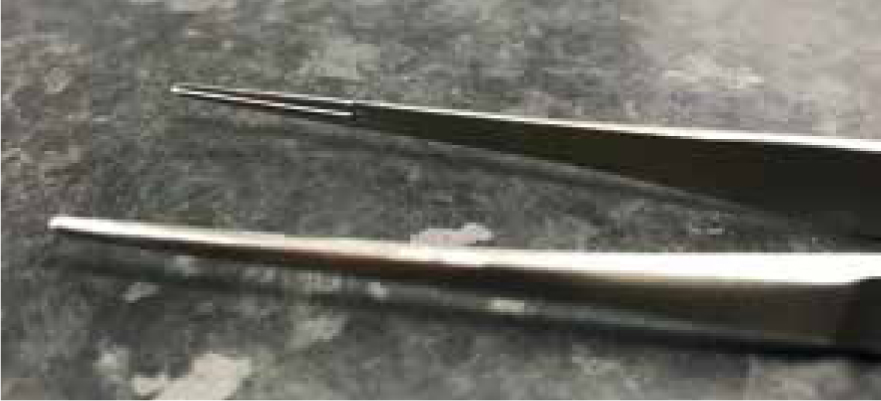
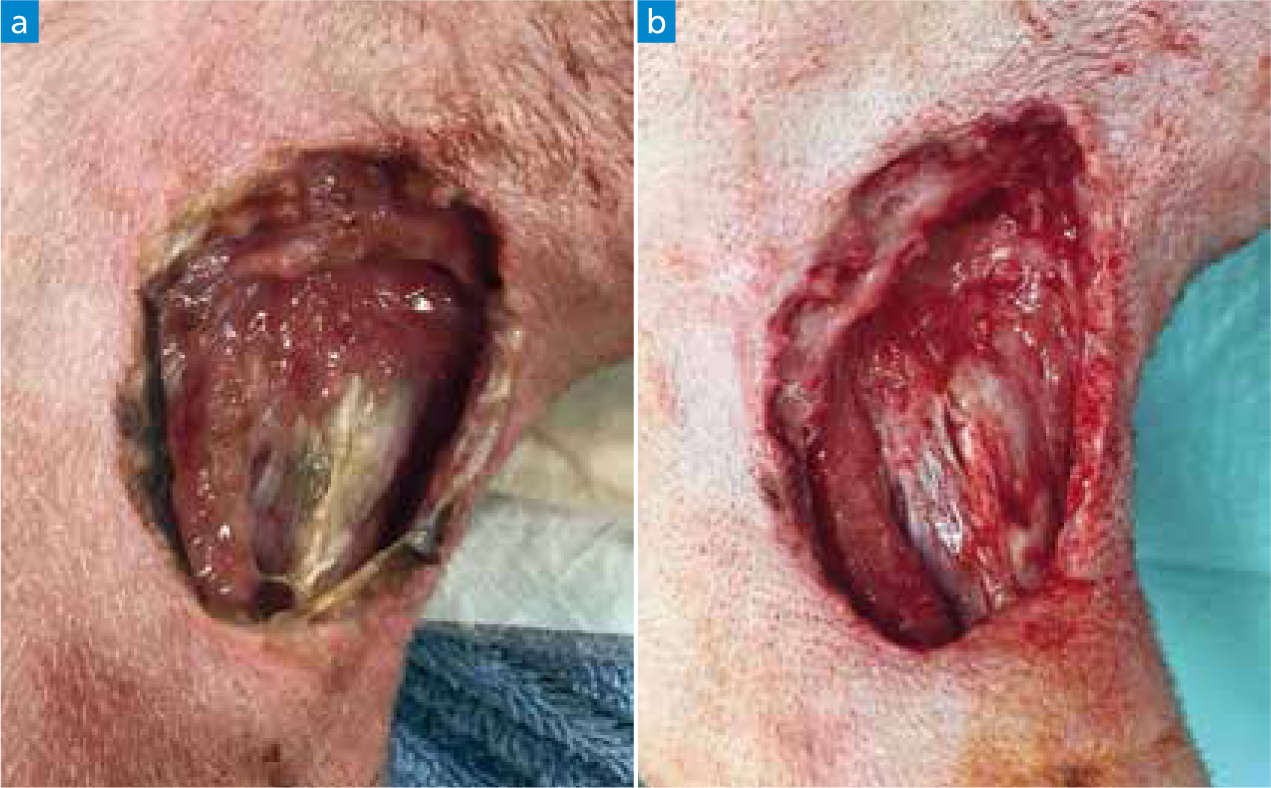
Layered surgical debridement can be used to minimise the risk of debriding healthy tissues (Welsh and Sumpling, 2015). Tissues that are brown, black or green are considered non-viable and can be removed. Any pink, red or well attached tissue should be preserved and this can always be removed at a later date if it does become non-viable (Davidson, 2015). Layered surgical debridement, where tissue is removed gradually in layers, allows conservation of tissue in areas such as the distal limbs, where there is inadequate skin to allow a large amount of tissue removal. It is performed until the visible devitalised tissue has been removed and therefore haemorrhage occurs from the vessels in the wound edge or bed. By using this technique, there is a reduced risk of contamination of the deeper tissues with any debris from the superficial layers of tissue (Aldridge, 2013).
En bloc debridement is used where there is adequate normal tissue present to allow closure after the debridement has occured even when all the affected tissue has been excised. The en-bloc technique is often restricted in its use due to the size and sometimes the location of the wound. For example the limb is not an area in which this technique can be used due to the location of nerves and tendons, but it lends itself to debridement of the trunk (Aldridge, 2013). The wounds are required to be packed with sterile gauze swabs and then closed temporarily with sutures or towel clamps. The whole wound is then excised including the margin of healthy tissue, which leaves a clean wound for wound healing to occur.
In conjunction with surgical debridement hydro surgery can be helpful as an additional tool. The Versajet (Smith and Nephew) is the most commonly used unit in human medicine (O'Dwyer, 2016) where the tissue is cut with a saline stream and the vacuum effect removes the tissue and debris along with the saline, which leaves a clean wound bed (Aldridge, 2013). It efficiently reduces bacteria and biofilms along with the unwanted tissue, and has greater precision that a scalpel and reduced peripheral tissue damage (Cornell et al, 2010). Human comparative studies have shown that the Versajet is equally and possibly more effective than standard surgical debridement as less damage is caused to the remaining viable tissue (Sainsbury, 2009). It is most effective in the stages of layered debridement (Aldridge 2013).
Mechanical wet-to-dry dressings
Mechanical debridement can be achieved through dressing methods such as the ‘wet to dry’ and ‘dry to dry’ techniques, and dressings need to be regulary changed throughout the healing process by forceful tissue removal (Hamilton and Kožár, 2017). Dressings are applied wet, and allowed to dry against the tissue which requires debridement (Davidson, 2015), or dry as demonstrated in Figure 4. When either of these methods are used, as the dressing is removed the necrotic tissue is removed along with it (Aldridge, 2013). It can however take healthy tissue and destroy epithelial cells too as it is non-selective, so it lends itself to use on large wounds with a lot of unhealthy tissue (Davidson, 2015). The open weave of the gauze swabs used allows the fibres to become embedded into the wound, therefore this method can be painful to the patient when the dressings are removed and often requires sedation for dressing changes (O'Dwyer, 2016). Methods such as the ‘tie-over’ technique can be used to secure these dressing to difficult areas (Aldridge, 2013). Ideally these dressings need to be changed every 24 hours (Woodlands, 2014), but sometimes require changing up to three times daily when wounds are highly exudative (Davidson, 2015). Although this method has been used for a long period of time, there are many advanced debridement techniques available on the veterinary market which are more comfortable for the patient, and require fewer dressing changes (Davidson, 2015).
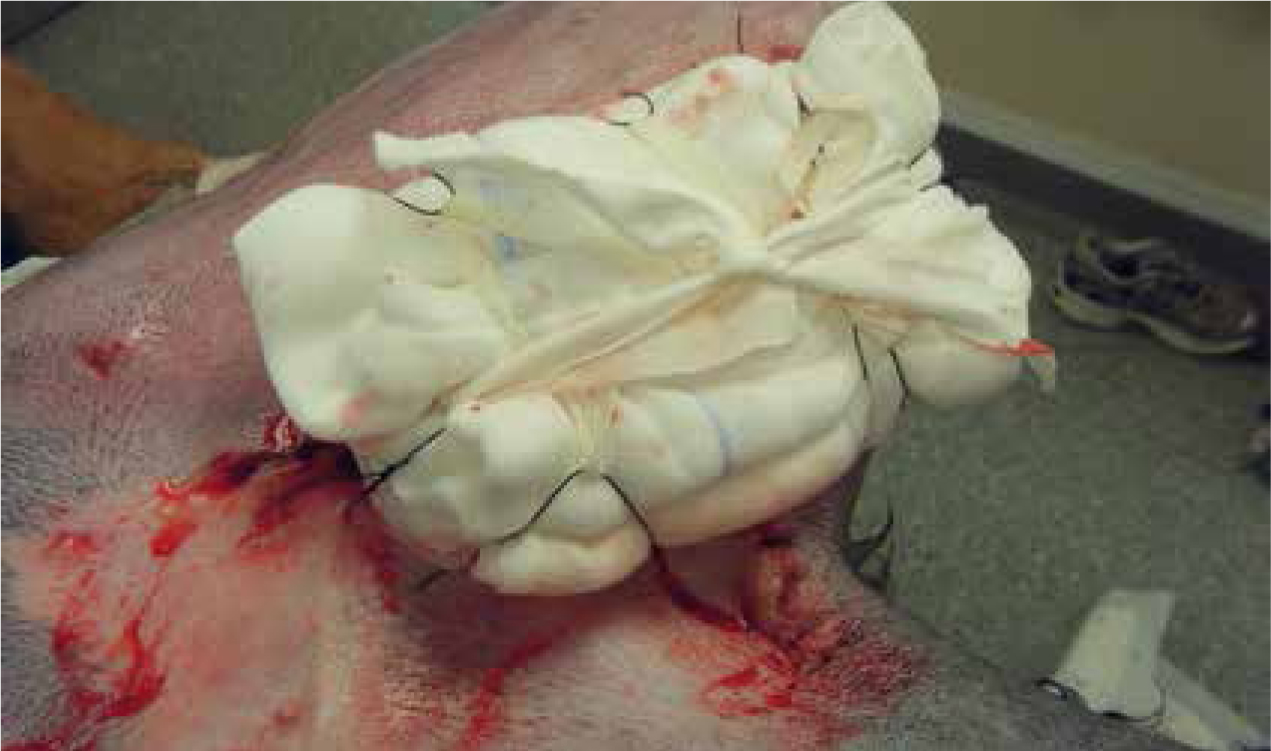
Mechanical debridement pads
Monofilament debridement pads have been established in the veterinary market after success in human medicine. Various studies have been conducted comparing debridement pads, such as Debrisoft® (Lohmann & Rauscher), to saline gauze swabs, hydrogel and maggot therapy (Meads et al, 2015). Debrisoft® is a single use polyester monofilament fibre pad which is wiped across the wound bed in a circular or vertical motion (Figure 5). The pads comprise 18 million specially angled fibres (O'Dwyer, 2016) and are also available as a ‘lolly’ for cavity wounds (Figure 6). Necrotic cells and debris are caught within the fibres of the pad and then removed (Atkin, 2016). The pad or lolly is easy to use and is effective without damaging the surrounding healthy tissue (Atkin 2016). Meads et al's (2015) study concluded that there was a reduction in pain when Debrisoft® was used, along with more effective debridement as more devitalised tissue was removed compared with the more standard treatments of autolytic, gauze swabs, and surgical debridement. Conclusions by National Institute for Health and Care Excellence (NICE) was that Debrisoft® enables quicker debridement of the wound bed of chronic and acute wounds, with fewer re-visits required, than with other standard methods, and therefore is a cost saving to the patient or health services (Meads et al, 2015).
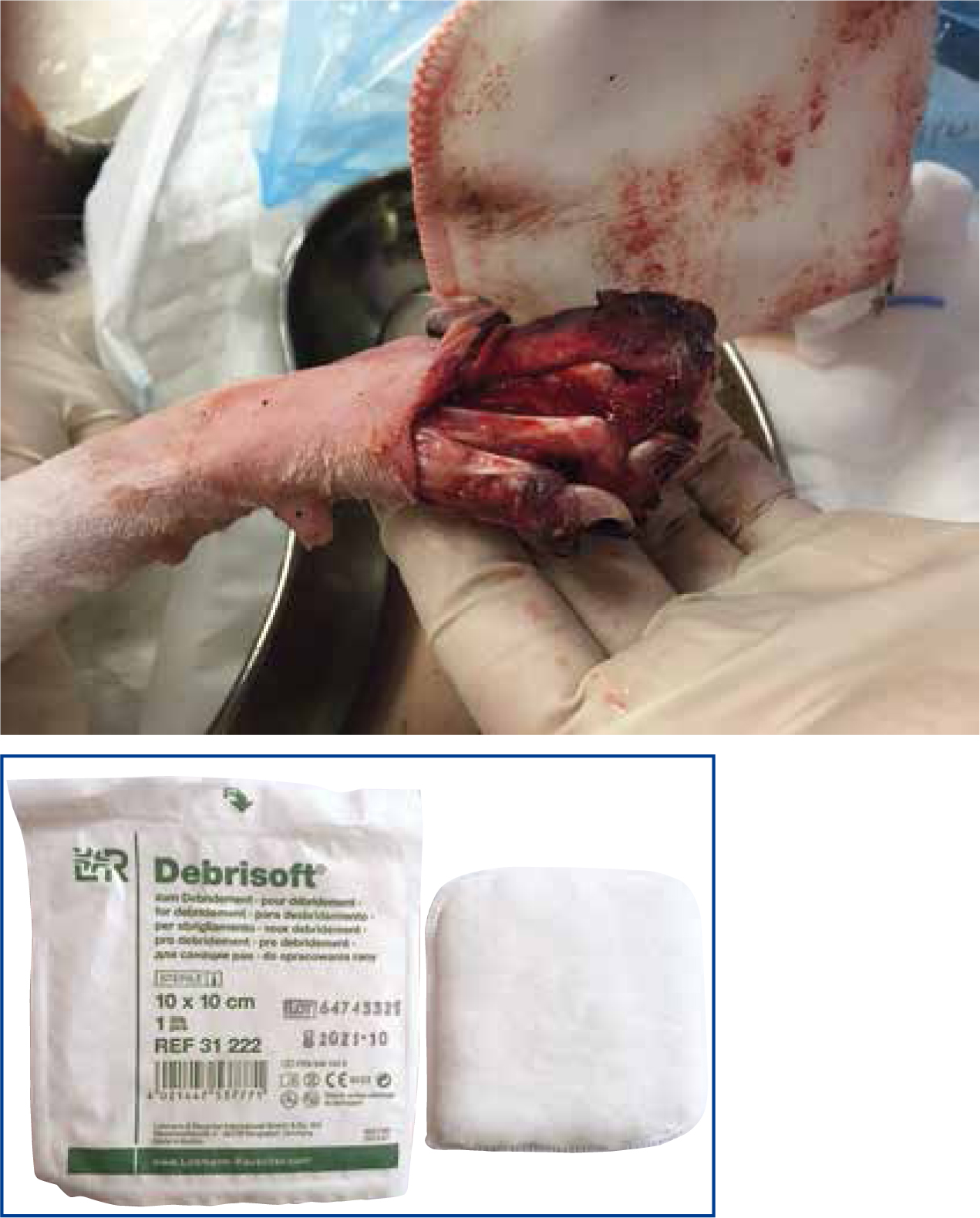

Selective debridement
Enzymatic
Enzymatic debridement uses chemical enzymes to assist in the healing of a wound by selectively targeting necrotic tissue and liquefying both coagulum and bacteria biofilms (Davidson, 2015), but is not commonly used in veterinary medicine (Hamilton and Kožár, 2017). The enzymes assist in removing dead tissue and normally are in a form of ointment for topical application. Such preparations contain streptokinase, trypsin, fibrinolysin, protease or collagenase (Davidson, 2015). Collagenase-based products are most commonly used in enzymatic debridement. They have specific activity breaking the peptide bonds in collagen of necrotic and non-viable cells within the wound bed. In human studies collagenase increases healing of the wounds, resulting in reduction in the size of the wound (Hamilton and Kožár 2017). When applying enzymatic agents it is essential that the ointment is therefore only applied to the tissue requiring debridement to prevent damage to healthy tissue, as maceration can occur to intact skin (Davidson, 2015). Preparations should be covered with a wound dressing and dressings changed every 12 to 24 hours (Davidson, 2015). The healing process with this method is shorter than with other techniques, but may be more expensive than other methods discussed due to frequency of dressing changes (Davidson, 2015). This method is useful if the patient cannot undergo general anaesthesia (Hamilton and Kožár, 2017), or if surgical excision is contraindicated (Davidson, 2015). Some patients will undergo some inflammation through this method, which may be more painful painful than other dressing techniques.
Bio surgical
Maggot therapy can be used to debride wounds that are necrotic or infected (Davidson, 2015). Maggots used are disinfected sterile fly larvae and the method has been used in human medicine for centuries especially prior to the development of antibiotics (Jones and Wall, 2008). The maggots selectively digest necrotic or infected tissue from a wound as they secrete proteolytic digestive enzymes into the wound (Atkin, 2016) and they consume up to 75 mg of tissue per 24 hours when they are placed at a density of 5–8 per cm2 (Davidson, 2015) or 5–10 per cm2 (Jones & Wall 2008). Their use extends to lysis of bacteria such as meticillin-resistant Staphylococcus aureus (Choudhary et al, 2016). This method does not normally cause any bleeding and adverse reactions are rare (Cornell et al, 2010), but in humans this method is reported to be uncomfortable and in some cases causes severe pain (Jones and Wall, 2008). Any bleeding that is seen is normally due to erosion of small blood vessels which are near to the surface of the wound bed and it is recommended that maggots are not placed on wounds near to major vessels (Jones and Wall, 2008; Choudhary et al, 2016). The pain is thought to be related to the change in pH within the wound which occurs by the maggots secretory and excretory products, and from the physical movement of the maggots within the wound (Jones and Wall, 2008). These products also may cause iatrogenic ammonia toxicity resulting from absorption of ammonia into the bloodstream, so it is important to ensure only the correct number of maggots are applied to the wound bed and treatment should be monitored closely (Jones and Wall 2008). Maggots do require a certain temperature, oxygen supply and a moist wound surface which is achieved by placing under a bandage with a hydrocolloid or within a dressing (Davidson, 2015). They are normally removed and replaced every 48 to 72 hours (Davidson, 2015).
Autolytic
Autolysis is the body's natural debridement as a wound is healing, removing any dead tissue present but sparing healthy tissue (Davidson, 2015). This is a slow but less painful method of debridement and works optimally when the wound surface is moist (Atkin, 2016). Enzymes soften the necrotic tissue and a moist environment will encourage swelling of tissue and loosen it from the wound bed (Aldridge, 2013). Dressings which help to achieve this are hydrocolloids and can be occlusive or semi occlusive. Semi-occlusive dressings are preferable as they allow oxygen to reach the wound bed for aerobic metabolism and therefore the formation of granulation tissue, fibroblast formation, wound contraction and epithelisation (Davidson, 2015). Natural wound exudate contains endogenous enzymes, growth factors and cytokines which all stimulate angiogenesis, granulation tissue formation and epithelisation of the wound bed (Davidson, 2015). Phagocytosis can occur in a moist wound environment as moisture allows migration of the white blood cells (Hamilton and Kožár, 2017). Covering the wound with a bandage can also keep the wound edges warm which increases enzymatic activity (Davidson, 2015). Negatives of this method being used alone are that it is a slow process and infection can occur within the wound, especially as it could be open for a prolonged period of time (Hamilton and Kožár, 2017). The process can be accelerated with the use of negative pressure wound therapy (NPWT) or vac-assisted closure (VAC) (Figure 7) which can aid in exudate management and encourages development of a healthy granulation wound bed (Bell, 2016). Honey can be used to aid autolytic debridement (Figure 8) while having an antimicrobial effect on the wound bed (O'Dwyer, 2016). The honey osmotically draws fluid from the surrounding tissues, reducing wound oedema and promoting debridement (Aldridge, 2013).
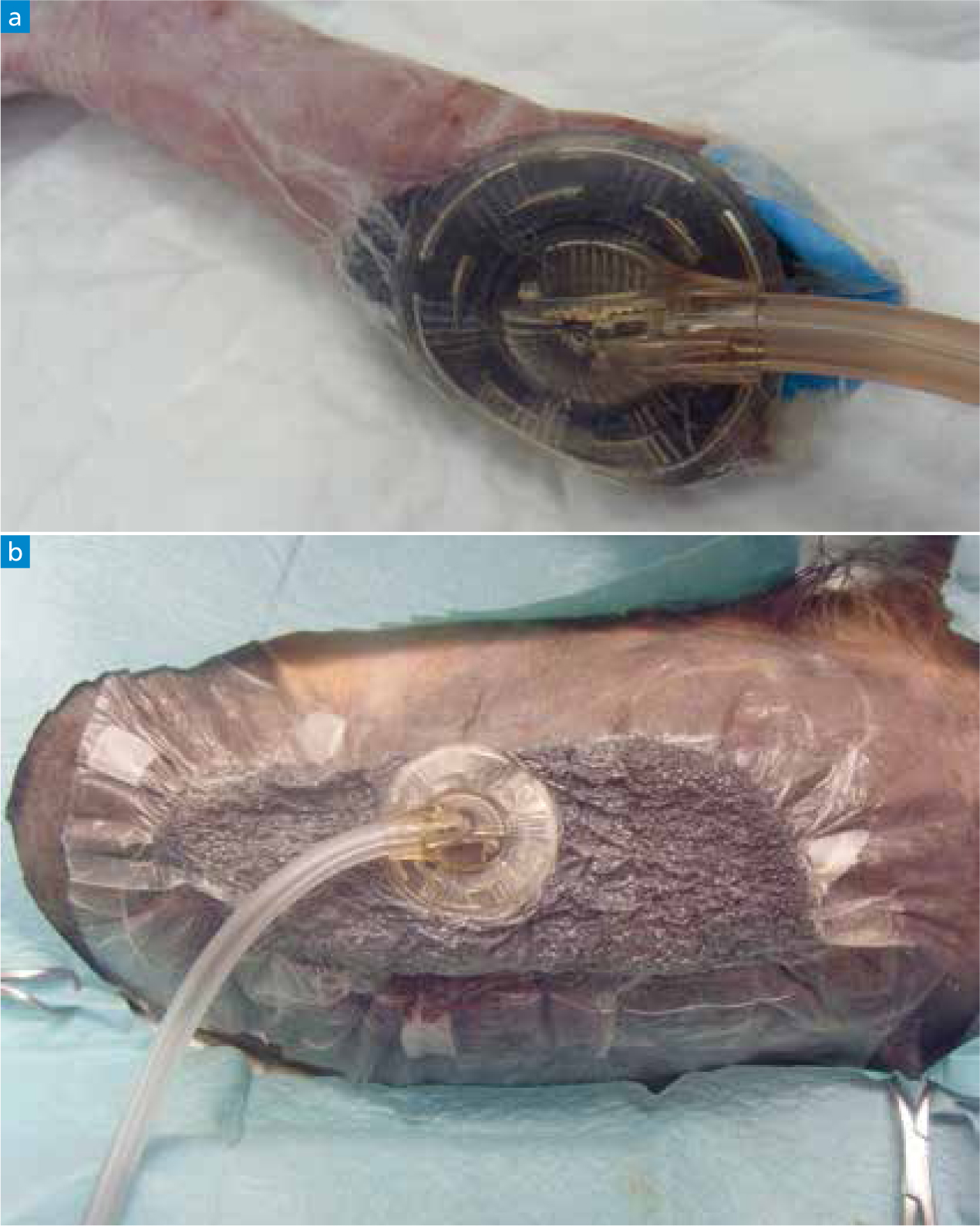
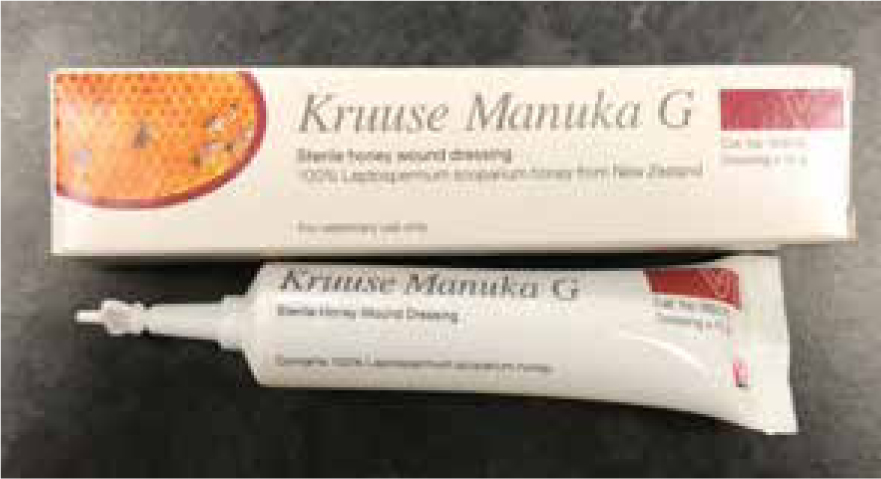
Conclusion
In conclusion there are many different methods of debridement. Multiple methods may be applied to a wound at varying stages depending on the size, age, aetiology and patient status. Debridement should be performed to encourage wounds to move through the three stages of healing, to reduce hospitalisation for the patient to reduce nosocomial infections, to reduce repeated treatments and sometimes repeated chemical restraint, and to minimise the cost to the client. It is essential that clinical staff undertaking debridement are informed and have working knowledge of the various debridement methods, so that the correct method can be adopted for the wound presented and the patient status, to ensure a quick recovery.

